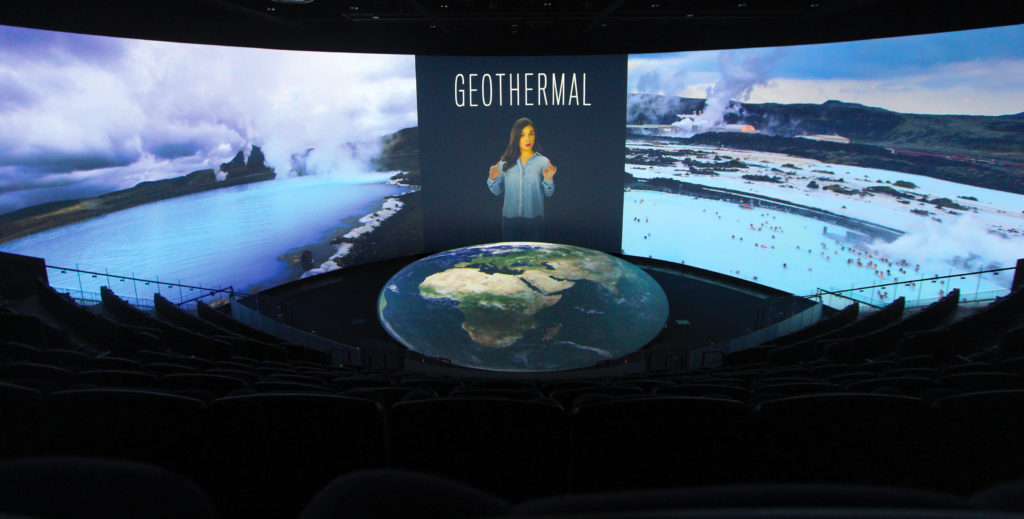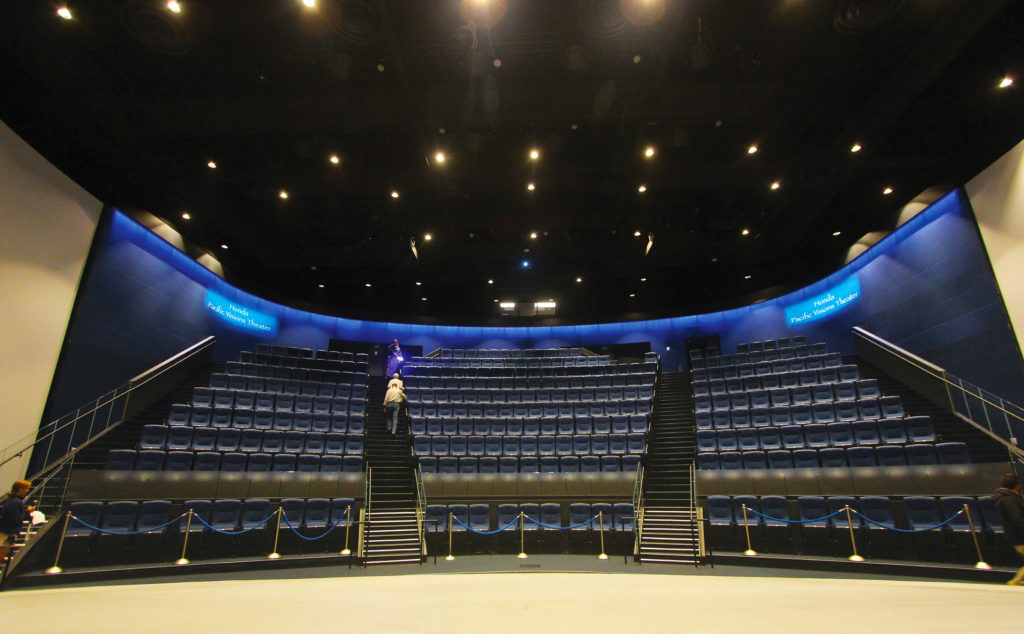How do you tell the story of the world’s oceans? Their endless blue waves defy easy summary. Miles in depth, teeming with life, and nearly as old as the Earth itself, oceans remain as mysterious now as in ages past. “Designing Our Future,” the film made for the Honda Pacific Visions Theater, was created to shed light on one aspect of that great blue mystery: how it influences, and is in turn influenced by, the several billion people who share the planet.
Featuring high-resolution footage of marine animals, animated segments and computer-generated imagery, “Designing Our Future” is the center of the Pacific Visions experience. Highlighting the link between humanity and the ocean, the narrative ranges from the beginning of life itself to the challenges of the present moment – namely, providing enough food, water and energy for all. Media company Cortina Productions produced the film with guidance from Dr. Jerry Schubel, the Aquarium of the Pacific’s president and CEO, as well as input from science advisors, artists and marine experts.
Dr. Douglas McCauley, assistant professor at the Department of Ecology, Evolution and Marine Biology at the University of California, Santa Barbara, consulted on the project. “The Aquarium brought together . . . scientists, thinkers and writers. It was just a delightful series of days to sit down and really grapple with some of these questions,” McCauley said. “They wanted to hear in our own words what we thought the most important parts of the past and future were for oceans.”

Joe Cortina, founding partner and creative director of Cortina, said Schubel wanted to do more than just entertain or educate. His vision was to teach “stewardship” of the ocean. “He’s always very ambitious in wanting to make sure that not only is it an aquarium for people to enjoy seeing live animals, but also that it’s a teaching environment,” Cortina said of Schubel.
Cortina’s company has worked on various projects at the Aquarium for over a decade. Their first collaboration, “Whales: Voices of the Sea,” featured a catalogue of whale sounds that visitors could attempt to mimic on a spectrograph. The exhibit went on to win the 2005 MUSE Silver Award from the American Association of Museums’ Media and Technology Committee.
With “Designing Our Future,” Cortina aimed to tell a story that enumerated the problems of today without losing the audience to despair. “Everybody’s struggling with how to address some of the environmental challenges that we have now with the planet, and not do it in a way that turns people off, but in a way that’s positive. I think this project, more than anything we ever worked on, does that,” Cortina said.
In the film, after introducing the challenges of food scarcity and energy production, solutions are presented in the form of ocean-based technologies that could eventually be commercialized. Offshore aquaculture farms would provide food and help to stabilize eroding shorelines, desalination plants could transform the ocean into the most abundant source of fresh water, and renewable, non-polluting energy could be derived from solar, wind and tidal power.

“[The film] introduces the history of the whole planet and how the ocean is an essential part of that, and then goes through the different technologies and innovations that can really play a huge part in relation to the ocean,” Katie Engel, a producer at Cortina, said.
Computer-generated graphics in the film visualize a future built on this new technology. It wasn’t enough to envision an “okay future” or a merely sustainable future, Cortina said, but a great future for both humans and the ocean. It’s a contrasting vision to the bombed-out dystopias offered by Hollywood, he noted. “So much of what younger people see now about the future is either apocalyptic futures in movies or stories about how the planet isn’t going to be in very good shape by the time we grow up. The idea is to get them invested in the future, and that all these things we’re facing are achievable.”
McCauley lauded the Aquarium for its Pacific Visions expansion, which he said empowers visitors to think about how they can make a difference. “They’re in a great position to get people on their own journeys thinking about what’s going on in the oceans,” he said. “I really admire that the Aquarium has taken on this extra charge of responsibility of saying: look, come see it [and] love it like we do. But just like we do, when you love it you have a responsibility, which is to care for it.”
Tom Bowman, whose company Bowman Change designed the Pacific Visions Culmination Gallery in partnership with Cortina Productions, said the dual message of inspiration and information was the founding principle of the Aquarium’s new wing. “What’s not productive is to overwhelm people with fear, because people become paralyzed,” he said. “What proves to be more productive is not fear but worry, and especially worry that’s combined with hope. Because if you’re worried about something but you’re hopeful, you can do something about it – you’ll be motivated to do something about it.”
With Pacific Visions and its signature film, Schubel said he was excited to present the Aquarium’s vision to the public. “The theater, we hope, will really make an emotional connection with people,” he commented. “Every time I look at that film, I find it very moving.”
